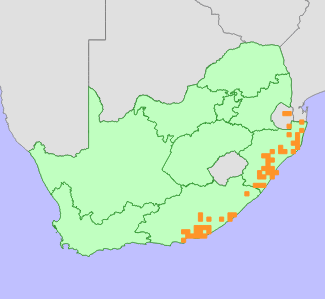|
Scientific Name | Senecio brachypodus DC. |
Higher Classification | Dicotyledons |
Family | ASTERACEAE |
Synonyms | Senecio natalensis Sch.Bip. |
National Status |
Status and Criteria | Least Concern |
Assessment Date | 2020/03/04 |
Assessor(s) | L. von Staden |
Justification | Senecio brachypodus is a widespread and common species. It is declining in parts of its range, but not yet in danger of extinction. |
Distribution |
Endemism | Not endemic to South Africa |
Provincial distribution | Eastern Cape, KwaZulu-Natal |
Range | This species is widespread in the Eastern Cape and KwaZulu-Natal, from the Suurberg to Uitenhage, extending along the east coast to Maputaland in northern KwaZulu-Natal. It also occurs in Mozambique and eSwatini (Swaziland). |
Habitat and Ecology |
Major system | Terrestrial |
Major habitats | Zululand Lowveld, Bhisho Thornveld, Eastern Valley Bushveld, KwaZulu-Natal Hinterland Thornveld, KwaZulu-Natal Coastal Belt Grassland, Kasouga Dune Thicket, Maputaland Coastal Belt, Maputaland Pallid Sandy Bushveld, Thukela Valley Bushveld, KwaZulu-Natal Coastal Belt Thornveld, Crossroads Grassland Thicket, Fish Valley Thicket, Grahamstown Grassland Thicket, Nanaga Savanna Thicket, Sundays Mesic Thicket, Albany Valley Thicket, Escarpment Mesic Thicket, Maputaland Wooded Grassland, Albany Mesic Thicket, Transkei Coastal Belt, South Eastern Coastal Thornveld, Southern Lebombo Bushveld, Western Maputaland Clay Bushveld, Muzi Palm Veld and Wooded Grassland, Granite Lowveld, KwaZulu-Natal Sandstone Sourveld, Pondoland-Ugu Sandstone Coastal Sourveld |
Description | It occurs in the margins of coastal forests and in dry river valleys. |
Threats |
| This species has lost habitat to urban and coastal development, as well as agriculture along the KwaZulu-Natal coast and around Uitenhage and Port Elizabeth. Habitat loss continues. Field observations also indicate that some subpopulations are threatened by competition from alien invasive plants and habitat degradation due to overgrazing and too frequent and intense fires. |
Population |
Population trend | Decreasing |
Assessment History |
Taxon assessed |
Status and Criteria |
Citation/Red List version | | Senecio brachypodus DC. | Least Concern | Raimondo et al. (2009) | |
Bibliography |
Goldblatt, P. and Manning, J.C. 2000. Cape Plants: A conspectus of the Cape Flora of South Africa. Strelitzia 9. National Botanical Institute, Cape Town.
Hilliard, O.M. 1977. Compositae in Natal. University of Natal Press, Pietermaritzburg.
Raimondo, D., von Staden, L., Foden, W., Victor, J.E., Helme, N.A., Turner, R.C., Kamundi, D.A. and Manyama, P.A. 2009. Red List of South African Plants. Strelitzia 25. South African National Biodiversity Institute, Pretoria.
|
Citation |
| von Staden, L. 2020. Senecio brachypodus DC. National Assessment: Red List of South African Plants version 2024.1. Accessed on 2025/12/12 |
 Comment on this assessment
Comment on this assessment


